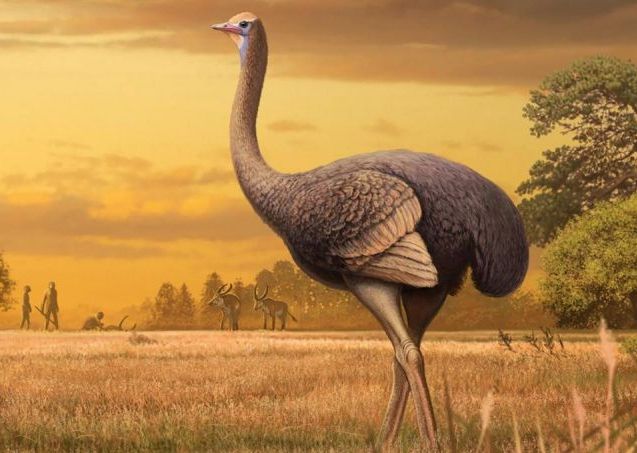Difference between revisions of "Rhea"
Tao alexis (talk | contribs) |
Tao alexis (talk | contribs) |
||
| (2 intermediate revisions by the same user not shown) | |||
| Line 3: | Line 3: | ||
| species = [[Birds (sage study)|bird]] | | species = [[Birds (sage study)|bird]] | ||
| noapp = 5–20 | | noapp = 5–20 | ||
| − | | behaviour = | + | | behaviour = flock |
| range = [[Alpine (range)|alpine]], [[Barrens (range)|barrens]], [[Savanna (range)|savanna]],<br>[[Steppe (range)|steppe]] | | range = [[Alpine (range)|alpine]], [[Barrens (range)|barrens]], [[Savanna (range)|savanna]],<br>[[Steppe (range)|steppe]] | ||
| − | | size = 5 ft. at head | + | | size = 5 ft. 6 in. at head |
| − | | weight = | + | | weight = 60 lbs. |
| int = 1 | | int = 1 | ||
| AC = 7 | | AC = 7 | ||
| Line 22: | Line 22: | ||
[[File:Rhea.jpg|left|350px|thumb]] | [[File:Rhea.jpg|left|350px|thumb]] | ||
__TOC__ | __TOC__ | ||
| − | Rhea are hunted for their meat, which is less fatty that other bird meats. Feathers from the rhea have been worn by numerous tribes and have been transported to Europe for the making of clothing and hats. Rhea skin, which has a distinctive, pebbly surface, is relatively strong and durable; it's used to make coin pouches, belts and even boots. | + | Rhea are hunted for their meat, which is less fatty that other bird meats. Feathers from the rhea have been worn by numerous tribes and have been transported to Europe for the making of clothing and hats. Rhea skin, which has a distinctive, pebbly surface, is relatively strong and durable; it's used to make coin pouches, belts and even boots. Oil rendered from the bird is locally used to make soap and cosmetics. The most practical way to hunt rhea is using the [[Bola (weapon)|bolas]]. |
== Behaviour == | == Behaviour == | ||
| + | Social by nature, rhea form loose flocks that can range from the number shown appearing to three times as many during the breeding season in the late spring or early summer, depending on the region. During the breeding season, males and females form pairs, with females laying eggs in communal nests, which can result in large clutches. Males take on the responsibility of incubating the eggs and caring for the chicks after they hatch. | ||
| − | + | Rheas are also known for their vocalizations, making a variety of sounds for communication within flocks or between mating partners. Males are aggressive about defending their territory around the communal nest during the breeding season. They can engage in physical confrontations to establish dominance or protect their territory. Natural predators include pumas and jaguars; large raptors like eagles or vultures target young birds, while giant forms commonly hunt adults. | |
| − | |||
| − | + | See [[Bestiary]] | |
| − | + | [[Category: Reviewed]] | |
| − | |||
| − | |||
| − | |||
Latest revision as of 22:55, 1 November 2023
| Species | bird |
| No. Appearing | 5–20 |
| Behaviour | flock |
| Range | alpine, barrens, savanna, steppe |
| Size | 5 ft. 6 in. at head |
| Weight | 60 lbs. |
| Intelligence | 1 |
| Armour Class | 7 |
| Hit Dice | 1 |
| Action Points | 5 |
| Max. Stride | 21 |
| THAC0 | 20 |
| Hp/Die | d4 |
| Attack Forms | 2: two talons |
| Damage | talons (1–6) |
| Special Attacks | none |
The rhea is a large flightless bird native to the grasslands of South America. Featuring a long neck and legs, the greater rhea is well-adapted for life on the South American pampas and lowlands, though they have been known to dwell throughout the shrublands and barrens of the Andean Plateau, up to 15,000 ft. above sea level. The bird's habitat favours a nearness to water sources, where it can forage and find sustenance.
Contents
Rhea are hunted for their meat, which is less fatty that other bird meats. Feathers from the rhea have been worn by numerous tribes and have been transported to Europe for the making of clothing and hats. Rhea skin, which has a distinctive, pebbly surface, is relatively strong and durable; it's used to make coin pouches, belts and even boots. Oil rendered from the bird is locally used to make soap and cosmetics. The most practical way to hunt rhea is using the bolas.
Behaviour
Social by nature, rhea form loose flocks that can range from the number shown appearing to three times as many during the breeding season in the late spring or early summer, depending on the region. During the breeding season, males and females form pairs, with females laying eggs in communal nests, which can result in large clutches. Males take on the responsibility of incubating the eggs and caring for the chicks after they hatch.
Rheas are also known for their vocalizations, making a variety of sounds for communication within flocks or between mating partners. Males are aggressive about defending their territory around the communal nest during the breeding season. They can engage in physical confrontations to establish dominance or protect their territory. Natural predators include pumas and jaguars; large raptors like eagles or vultures target young birds, while giant forms commonly hunt adults.
See Bestiary
